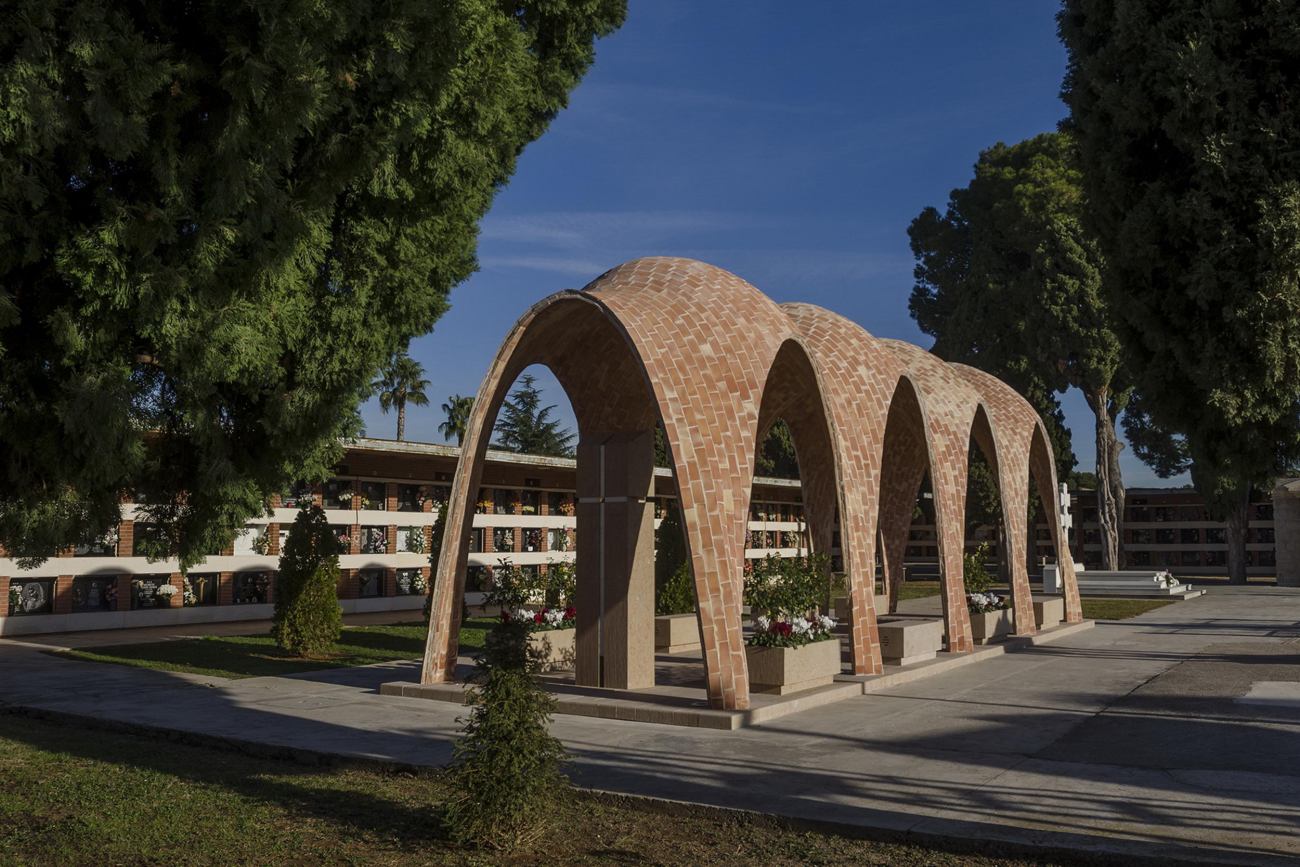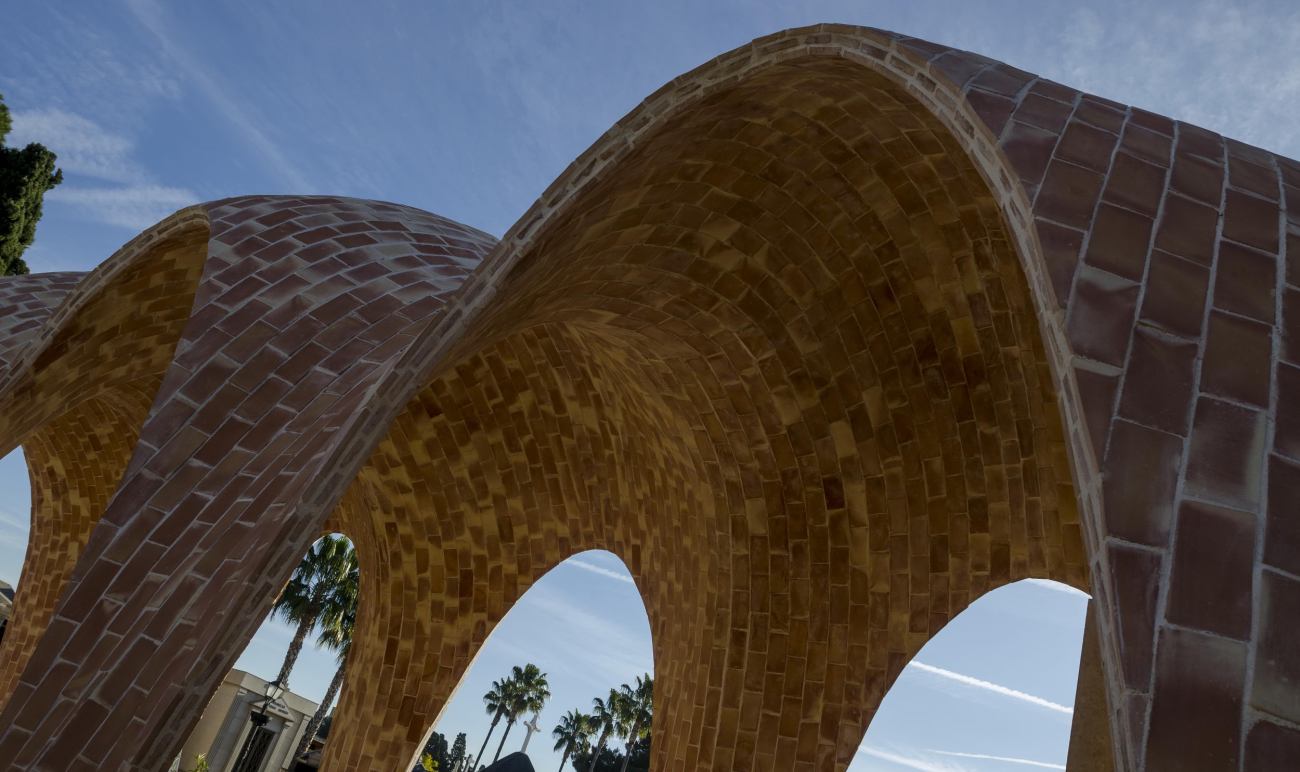| 公司: | Vegas & Mileto | 类型: | 建筑 |
|---|---|---|---|
| 地区: | 西班牙 | 标签: | 宗教空间 | 教堂 |
这座拱顶项目由建筑师Fernando Vegas和Camilla Mileto合作设计,在Salvador Gomis under the supervision of Salvador Tomás的监督下建造。建筑向该地区丰富的陶瓷制作传统和典型的瓷砖拱顶技术致敬,这种技术曾在整个西班牙东部广泛传播。
This vault was designed by architects Fernando Vegas and Camilla Mileto and executed by Salvador Gomis under the supervision of Salvador Tomás. It was created as a tribute both to the region’s rich ceramic-making tradition and to the characteristic tile vault technique, historically widespread throughout the East of Spain.
这种技术来自瓦伦西亚建筑师Rafael Guastavino,在现代主义建筑师中广泛传播,其中最著名的是高迪。在美国,这种技术成为他和他的故乡的代名词。
This technique was disseminated by Valencian architect Rafael Guastavino both among modernist architects, most notably Gaudí. In the United States the technique came to be synonymous with him and his place of origin.
设计这座教堂需要特殊的3D程序,建筑师经过连续23次的修改才最终确定方案,旨在获得最佳的美学和结构效果。教堂中的所有曲线都是使用悬链线轮廓制作而成。设计师耗费巨大心力将这些曲线用数学和图形方式表达,以优化建筑的整体结构。
Special 3D programs were required to design the pantheon and the final solution was only agreed on after 23 consecutive variations aiming for optimum aesthetic and structural results. All the curves in the pantheon were produced using catenary profiles. These curves are incredibly difficult to express mathematically and graphically to successfully optimise the construction’s overall structural operation.
▽结构示意
建筑使用了约2万块手工瓷砖,这些瓷砖从选土、燃料选择到火焰温度、质地、耐久性和老化速度都经过测试,它们的尺寸和厚度都取决于教堂的曲线,以及三层陶瓷砖的必要重量,以抵消风带来的气压影响。
Close to 20,000 handmade ceramic tiles were used in construction following tests to establish the type of clay, fuel and flame, texture, durability and aging tests. The size and thickness, both dependent on the curves of the pantheon, and the necessary weight were calculated for the three ceramic layers to compensate for the effect of wind suction.
拱顶由四个相互连接的双曲抛物面组成,十分轻盈,但具有坚固性,因此建造无需模架,只使用一些金属导轨来确保曲率一致。
The vault is comprised of four interlinked hyperbolic paraboloids and is very light yet incredibly resistant because of its curves. Formwork was not required and only some metal guides were used to ensure curvature was guaranteed at all times.
该结构经过精心研究,以便建造过程中可以使用完整的砖块,避免切割或修补接缝。建筑仅使用砖,灰泥和白水泥建造,无需钢筋混凝土。尽管如此,教堂拱顶的设计也能够承受地震,因为其刚性曲线以及在相接处添加的玻璃纤维棒可以有效吸收地震产生的剪力。
The structure was carefully studied so that entire bricks could be used, avoiding trimmings or patching up joints. It was built using only brick, plaster and white cement, and did not require reinforced concrete. Nevertheless, the pantheon vault is designed to withstand possible earthquakes given the rigid curves and the addition of fiberglass rods at the springings to absorb shear force.
拱顶的总建造重量约为12.5吨,大大低于传统的采用砖墙和混凝土建造的教堂,相同体积下,传统教堂的重量可能在15到20倍之间(在190到250吨之间)。这些数字揭示了与其他更常见的结构相比,建筑在能源和材料方面的节省,以及瓷砖拱顶的多功能性。
The total constructed weight of the vault is approximately 12.5 tonnes, considerably less than a traditional pantheon with brick walls and concrete floors and ceilings, which could weigh between 15 and 20 times as much (between 190 and 250 tonnes) for the same volume. These figures reveal the savings in both energy and material, as well as the versatility of the tile vault compared to other more common constructions.
地板由大约50种不同形状的Cenia石砖组成,设计和放置形成一个各向同性的图案,并在四个模块中重复。拱顶的外部照明由嵌入拱顶铺地中的配件提供。长椅是Cenia石块制作的实心块,专门留出壁龛和插座的通风口。花坛也由单独的Cenia石块组成,中部挖空,并在底座上设置细小穿孔用于排水。
The flooring is made up of approximately 50 different shapes of Cenia Stone tiles designed and placed to form an isotropic puzzle which is repeated in all four modules. The external lighting of the vault is provided by fittings embedded in the paving at the foot of each of the vault springings. The benches are solid blocks of Cenia stone specifically sculpted to incorporate the ventilation of the niches and sockets. Plant holders are also individual Cenia stone blocks which have been hollowed out and incorporate imperceptible perforated drainage on the base.
中央铺装采用双重防滑涂层瓷砖,用曲线和反曲与拱顶相呼应。这些瓷砖是由陶艺家Enric Mestre设计和制造,他还设计了礼拜堂顶部的巨石和陶板。地下室中使用的板坯由一块重约一吨的Cenia石头开凿和生产,由Unisystem安装的导轨和滑轮,使得运输可以毫不费力。内部在Porcelanosa Group Butech面板光滑饰面的长空间中,设有24个壁龛和12个骨灰龛的空间,天花板上用简单的线性LED配件照亮。
The central paving uses double slip-coated ceramic tiles, playing with curves and counter-curves in dialogue with the vault. These tiles were designed and manufactured for the occasion by ceramist Enric Mestre, who also designed the monolith and the ceramic panel at the top of the pantheon. The slab used in the crypt, a single piece of Cenia stone weighing about a tonne was extremely difficult to extract and produce, but can be slid effortlessly thanks to the rails and wheels attached to the back and installed by Unisystem. Inside, in the long space with smooth finishes from Porcelanosa Group Butech panels there is room for 24 niches and 12 columbaria, lit with simple linear LED fittings on the ceiling.
▽夜景
▽平面及剖面图
Technical Data
Location: Municipal Cemetery, Villarreal (Castellón)
Client: Soriano – Manzanet Family
Date: 2015
Design & project managment:
Camilla Mileto & Fernando Vegas, architects (UPV)
Universitat Politècnica de València
Design team:
M. Soledad García Sáez
Lidia García Soriano
F. Javier Gómez Patrocinio
Lighting: Elías Hurtado Pérez, engineer
Construction Manager: Salvador Tomás Márquez, quantity surveyor
Structural calculations: Adolfo Alonso Durá, architect
Construction Company: Construcciones Angose S.A.
Vault builder: Salvador Gomis Avíñó
Pottery artist: Enric Mestre Estellés
Restorer: Noema Restauradores S.L.
Bricks: Anticfang S.L.
Locksmith: UNISYSTEMS Porcelanosa Grupo
Natural Stone: Inmar Stone Group
Photographs: Vicente A. Jiménez and Salvador Tomás Márquez
更新日期:2022-09-02 15:15:45
非常感谢 Vegas & Mileto 带来的精彩项目, 查阅更多Appreciations towards Vegas & Mileto for sharing wonderful work on hhlloo. Click to see more works!





















